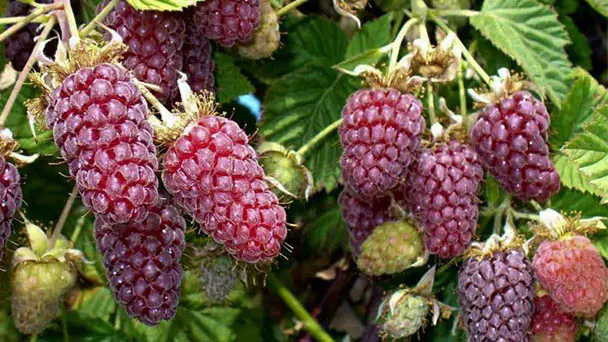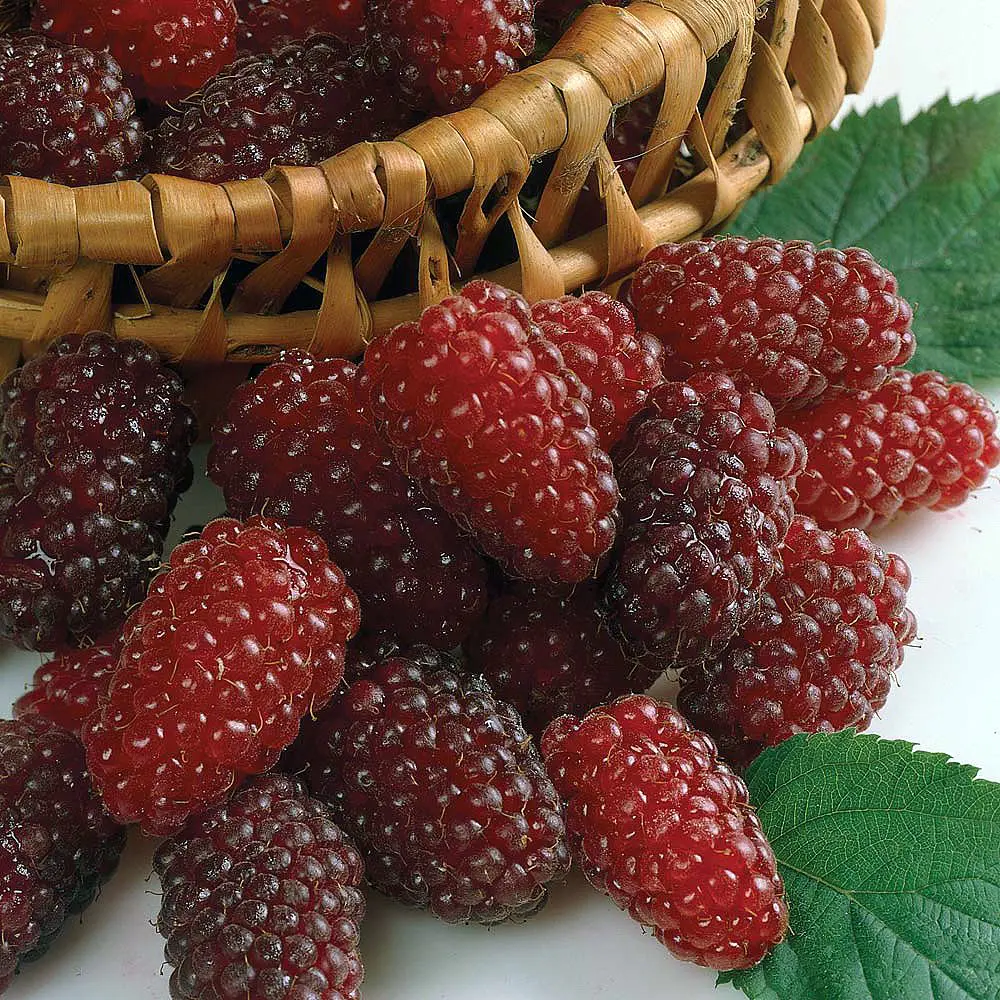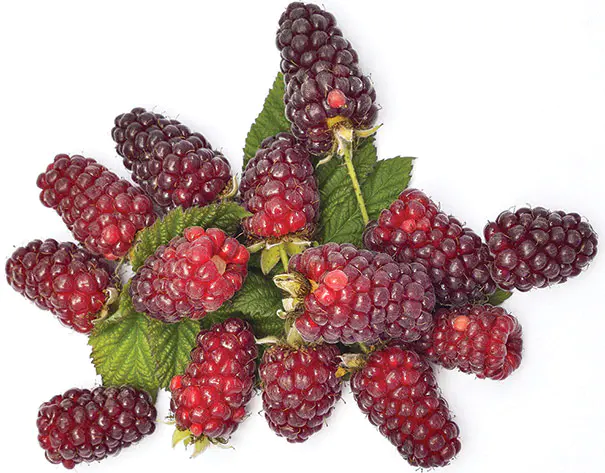How to Grow and Care for Loganberry (Rubus Loganobaccus)
Written by Ivy
Nov 11 2021

Loganberry is a vine of Rosaceae. Loganberry's fruit is green when it is young, turns red when it is puberty, and turns dark purple black when it is mature. The shape is long spherical or cylindrical. A large fruit formed by the aggregation of many small single fruits on the same receptacle. Loganberry has high nutritional value.

We should choose sand with better permeability. In this environment, loganberry can enter a rapid growth period, because this good permeability and water permeability can make loganberry maintain a good state while absorbing water and fertilizer, and protect roots at the same time.
In order to reduce the pollution of pesticides, we should not only pay attention to the selection of pesticides, but also strictly control the use of pesticides. We should use low concentrations as far as possible within the effective concentration range. The times of spraying should be determined according to the residual period and the degree of occurrence of diseases and pests. Do not arbitrarily increase the dosage, concentration and times of the agent, and improve the loganberry pest & disease control effect of the agent from the aspects of improving the application method and spraying quality.
There is a large amount of folic acid in loganberry. This substance is an important component necessary for pregnant women. It is particularly beneficial to fetal development and can reduce the occurrence of abnormal infants.
Loganberry is an excellent food source of trace element manganese. Experts say manganese helps the body form connective tissue and is essential for strong bones.
Loganberry can help relieve the problem of excessive pressure on the brain. Loganberry alone, like walnuts, can help strengthen the body and brain. Loganberry has a strong brain tonic effect and is a tonic very suitable for mental activists.
Loganberry Quick InfoWhen to Plant LoganberryWhen does Loganberry Bloom&HarvestLoganberry Care in DetailLoganberry WateringLoganberry SoilLoganberry LightLoganberry TemperatureLoganberry HumidityLoganberry FertilizerLoganberry PruningLoganberry RepottingLoganberry Pest & Disease ControlLoganberry PropagationLoganberry Propagation from CuttingLoganberry Propagation from SeedLoganberry Benefits
Loganberry Quick Info
| Botanical/Scientific Name | Rubus Loganobaccus |
| Common Name | Loganberry |
| When to Grow/Bloom/Harvest | Harvest late summer-early autumn |
| Uses | Used for juice or in jams, pies, crumbles, fruit syrups, and country wines |
| Origin | Santa Cruz, California |
| Light Care | Full sun or partial shade |
| Soil Care | Well drained soil |
| Temperature Care | A warm, but not baking hot summer |
| Humidity Care | Moisture-retentive |
| Watering | Keep well watered in their first growing season |
| Pruning Care | Prune loganberries in late summer or autumn |
| Fertilizer Care | Feed with 56g (2oz) of fish manure |
| Propagation | Layering or hardwood cuttings |
| Toxic | No toxic effects reported |
| Flower Color | White |
When to Plant Loganberry
Loganberry is usually planted in the early spring of each year. At this time, the planting density should be reasonably controlled and the planting hole should be dug. According to soil fertility and other factors, such as medium fertility, the plant row spacing shall be controlled at about 1.5X2m to ensure sufficient growth space for loganberry plants. If the soil is sticky and low fertility, we should use the method of ditch planting. After digging and planting along the line, we should apply enough base fertilizer. When we colonized loganberry, we separated the plant root from the fertilizer to prevent root burning. After colonization, we covered the root and stem of the plant. After loganberry is planted, we should pour enough root fixing water on it to improve the survival rate of seedlings.When does Loganberry Bloom&Harvest
Loganberry takes about three years to bear fruit after planting. In order to make BlackBerry trees bear fruit as soon as possible, we need to provide loganberry with appropriate water and keep the soil moist. We also need to provide loganberry with appropriate nutrients to make the plant grow more vigorously. We also need to supplement loganberry with appropriate light to promote plant flower bud differentiation.Loganberry Care in Detail

Loganberry Watering
Watering schedule for the first three weeks after loganberry planting: watering during the day. Water more frequently 2-3 weeks after planting. As a rule of thumb, the top inch of soil is wet for the first 2-3 weeks. Watering after the first three weeks: watering BlackBerry plants during the day Then, during the growing season, loganberry is given about 1 to 2 times a week, and at harvest, loganberry is given about 4 times a week. The roots of plants are shallow, so water needs to be on the surface.Loganberry Soil
When we choose to plant loganberry, we should first choose the soil with thick, soft soil, normal drainage and irrigation and rich organic matter. The soil pH is controlled at about 6.3 to ensure that the planting area can enjoy sufficient sunlight. If the soil organic matter is insufficient, the amount of base fertilizer shall be increased and the nutrient ratio shall be adjusted to ensure the healthy growth of loganberry. During land preparation, the depth of loganberry soil shall not be less than 30cm.We should choose sand with better permeability. In this environment, loganberry can enter a rapid growth period, because this good permeability and water permeability can make loganberry maintain a good state while absorbing water and fertilizer, and protect roots at the same time.
Loganberry Light
Loganberry needs a lot of light in the process of growth, so it is necessary to provide appropriate light for the plant when maintaining blackberry, so that loganberry can normally carry out photosynthesis and obtain nutrients. At the same time, sufficient light can also make loganberry feel the temperature difference, so as to stimulate the plant to differentiate flower buds and bear fruit.Loganberry Temperature
Loganberry does not require high temperature. Because loganberry is more temperature resistant, it does not need too harsh environment. Loganberry can tolerate relatively low temperatures.Loganberry Humidity
Loganberry flowering and fruit ripening are mostly in dry season. If there is insufficient water, the berries are small, the yield is low, and if there is too much water, the root rot phenomenon is more likely to occur. Therefore, the humidity control must be in place in the process of planting loganberry.Loganberry Fertilizer
The soil shall be thoroughly ploughed once a year in winter, and then an appropriate amount of base fertilizer shall be applied to each plant according to the planting quantity. In loganberry growth period, available nitrogen fertilizer should be mainly used, mainly in two periods: before flowering and fruit development. When topdressing, pay attention to the nutritional proportion and reasonably adjust the proportion of nitrogen, phosphorus, potassium and other nutrients. If nitrogen in loganberry soil is sufficient, phosphorus and potassium fertilizer shall be the main fertilizer, otherwise nitrogen fertilizer shall be the main fertilizer.Loganberry Pruning
Loganberry is a semi erect variety, so it is necessary to set up a bracket and lead the vine to the shelf when planting. A column about 5 meters high is erected in the orchard to promote the growth of loganberry. Then, loganberry pruning should be done well. When the sprouting branches grow to about 1.2m, they should be trimmed in time to control the growth height and promote the growth of plant lateral branches. Then tie it to the column to improve the permeability in the orchard. The loganberry should be trimmed at least three times a year to ensure the healthy growth of loganberry and create a good growth environment for it.Loganberry Repotting
Before starting loganberry repotting, we can use a small shovel to turn around the flowerpot and slowly take out the plants. After the plant is taken out, gently shake off the old soil attached to the root, properly trim the root with scissors and apply bactericide. The basin soil is suitable for sandy soil rich in humus, which can be prepared with rotten leaf soil, garden soil and feces. We also need to prepare slightly larger flower pots, fill them with soil, plant loganberry plants, water them and put them in a warm place.Loganberry Pest & Disease Control
After loganberry is picked, there are many advantages in pest control during this period. On the one hand, the pest activity ability is poor and the concentration intensity is high. On the other hand, loganberry plants in dormancy stage are also highly resistant to drugs, so we can use high concentration drugs for control. It is convenient to apply medicine on the leaves or pesticide on the branches.In order to reduce the pollution of pesticides, we should not only pay attention to the selection of pesticides, but also strictly control the use of pesticides. We should use low concentrations as far as possible within the effective concentration range. The times of spraying should be determined according to the residual period and the degree of occurrence of diseases and pests. Do not arbitrarily increase the dosage, concentration and times of the agent, and improve the loganberry pest & disease control effect of the agent from the aspects of improving the application method and spraying quality.

Loganberry Propagation
Loganberry Propagation from Cutting
When pruning Loganberry in winter, we can cut strong, full and disease-free branches to grow 8-12cm, cuttings with 2-3 buds and sand storage, and conduct loganberry cutting propagation before budding in early spring. We can bury the cuttings in the soil for 3-5cm and insert 40-50 cuttings per square meter. After planting, pour enough water and cover with straw, and then often keep the soil moist. The survival rate can reach 40-50% when the management is good, and more than 60% when it is high. It can be out of the nursery in the winter of that year. There are still many root segments left in the soil after loganberry cutting propagation, which can be used to continue seedling propagation. The specific method is to apply a small amount of organic fertilizer in the nursery in winter, turn it shallow once, press the fertilizer into the soil, prepare the land for border in early spring, and water it once in dry season. A large number of root tiller seedlings can sprout in April, leaving about 20 seedlings per square meter. Later, the management is the same as that of general nursery.Loganberry Propagation from Seed
The plant can carry out through loganberry propagation by seeds, but the seeds are very small and it is not easy to raise seedlings. Therefore, loganberry cutting propagation is generally used more in production!Loganberry Benefits
Lutein contained in loganberry can prevent the formation of retinal spots and UV damage to the eyes.There is a large amount of folic acid in loganberry. This substance is an important component necessary for pregnant women. It is particularly beneficial to fetal development and can reduce the occurrence of abnormal infants.
Loganberry is an excellent food source of trace element manganese. Experts say manganese helps the body form connective tissue and is essential for strong bones.
Loganberry can help relieve the problem of excessive pressure on the brain. Loganberry alone, like walnuts, can help strengthen the body and brain. Loganberry has a strong brain tonic effect and is a tonic very suitable for mental activists.
Latest Updated
- Benefits of Bugleweed - 7 Science-backed Health Benefits
- Bugleweed Dangers & Side Effects - Is It Poisonous?
- How to Plant Evergreen Trees - What You Should Know
- When to Plant Evergreens - Grow Guide for Evergreen Trees
- 12 Wonderful Evergreen Shrubs for Your Garden
- 12 Popular Evergreen Plants with Pictures for Beginners
- When And How To Prune A Lilac Bush Like a Pro
- How to Grow & Care for Lilac Vine (Hardenbergia Violacea)
- Japanese Lilac Tree (Syringa Reticulata) Care & Propagation Guide
- Shumard Oak Pros and Cons - What to Know
Popular Articles
- Winter maintenance of Antirrhinum Majus
- How to Grow Terminalia Mantaly Tree
- How to Grow and Care for Crossostephium Chinense
- How to grow Antirrhinum Majus in spring
- Peristeria Elata (Dove Orchid) Profile: Info & Care Guide
- Underwatered Snake Plant (Sansevieria Trifasciata) - Signs And How To Fix
- How to Care for Brazilian Jasmine Plant (Mandevilla Sanderi)
- How to Grow & Care for Graptopetalum Purple Delight in Summer
- Rosa Chinensis (China Rose): Plant Growing & Care Tips
- How to Care for Baby Sun Rose (Aptenia Cordifolia)